Exploring the Intricate Art and Science of Fractals
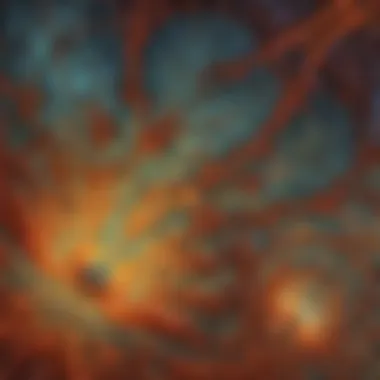

Intro
Fractals are unique structures that combine beauty and complexity. They appear in various forms in nature, like snowflakes and coastlines, displaying intricate patterns that repeat at different scales. This article promotes an understanding of the mathematical and artistic dimensions of fractals. It serves as a guide, specifically designed for young enthusiasts and their guardians.
By exploring both the science and art behind fractals, we can appreciate their significance and applications. With numerous methods to create these fascinating shapes, readers will discover how to engage with fractals in meaningful ways.
Science Fun Facts
Fractals have captivated mathematicians and artists alike for years. Below are some intriguing facts:
- The term fractal was coined by mathematician Benoît Mandelbrot in 1975. He defined them as complex patterns that are self-similar across different scales.
- Mandelbrot Set is one of the most famous fractals. It shows an incredibly detailed boundary that times infinite.
- Many natural objects, such as clouds, mountains, and trees, display fractal characteristics. Their patterns exhibit self-similarity and complexity.
"Fractals show how complex forms can arise from simple rules."
- The Barnsley Fern is a popular example of a simple algorithm that creates a detailed fractal shape.
Such facts highlight the unique and compelling aspects of fractals. They are not merely mathematical constructs, but also play significant roles in nature and art.
Discover the Wonders of Fractals
Understanding fractals involves more than just numbers. There are various resources to explore their beauty:
- Educational Videos: Platforms like YouTube feature several animated explanations. Search for videos explaining fractal geometry to see how these shapes develop visually.
- Interactive Learning Tools: Websites like en.wikipedia.org provide valuable insights. They often include interactive models showcasing fractals in different forms.
- Real-Life Applications: Fractals influence various fields, including television programming, computer graphics, and even medicine, where they model structures like blood vessels.
This exploration broadens our understanding of how fractals connect to our world.
Science Experiment Showcase
Creating fractals can be a fun and educational experience. Below is a simple experiment that can be conducted at home:
Fun and Engaging Experiment: Creating a Fractal Tree
Materials List:
- Paper
- Pencil
- Ruler
- Eraser
- Optional: Colored pencils or markers
Step-by-Step Instructions:
- Start with a straight line, drawn vertically, representing the trunk of the tree. This could be around 10 cm long.
- At the top of the trunk, draw two shorter lines at a 45-degree angle. These are the branches.
- From the tips of these branches, draw shorter branches at a similar angle. Repeat this step several times, making each subsequent branch about half the size of its parent branch.
- To add aesthetic value, color the branches using various shades.
Safety Tips and Precautions
- Ensure that the workspace is clean and free of hazards.
- Supervision may be needed for younger children using any tools.
This experiment demonstrates the self-similar property of fractals and allows children to create their own variations.
By engaging with fractals in this manner, learners can merge entertainment with educational value. They will not only grasp mathematical concepts but can also appreciate the artistry involved.
Understanding Fractals
The study of fractals offers a unique intersection of mathematics, art, and natural sciences. Understanding fractals is crucial, as they are not just abstract concepts but also fundamental to various fields including physics, biology, and even art. These intricate patterns can be observed in the natural world, such as in coastlines, mountains, and even in the structure of plants. By grasping what fractals are and how they function, learners can appreciate their beauty and complexity.
What Are Fractals?
Fractals are complex geometric shapes that can be split into parts, each of which is a reduced-scale copy of the whole. This property is known as self-similarity. Common examples include the Mandelbrot set and the Sierpiński triangle. The term "fractal" was coined by mathematician Benoît Mandelbrot in the late 20th century. Fractals often present in nature, such as snowflakes, plant leaves, and even weather patterns, demonstrate how these mathematical concepts translate into physical forms. Understanding the concept of fractals helps pave the way for deeper exploration in both science and art.
History of Fractals
The history of fractals can traced back to the early work of mathematicians such as Georg Cantor and Felix Klein. However, it was Benoît Mandelbrot's groundbreaking work in the 1960s and 1970s that truly popularized the concept. Mandelbrot's research focused on complex shapes and their properties; this laid the foundation for modern fractal geometry. As technology advanced, particularly in computer graphics, it became easier to visualize these complex patterns, leading to a surge of interest in fractals both in academic circles and popular culture.
Mathematical Foundations
The mathematical foundation of fractals hinges on concepts from geometry and dynamical systems. Key areas of study include:
- Iteration: Many fractals are generated by repeating a simple process over and over. This is often done through equations that map complex numbers.
- Recursion: This involves defining an object in terms of itself. For instance, the process of dividing a shape into smaller copies of itself.
- Non-linear Dynamics: Fractals often emerge from systems that exhibit chaotic behavior. This makes their study relevant in understanding complex systems in nature.
Understanding these mathematical principles is essential for anyone interested in creating or analyzing fractals. The ability to see the connections between mathematics and the natural world enhances overall comprehension of both.
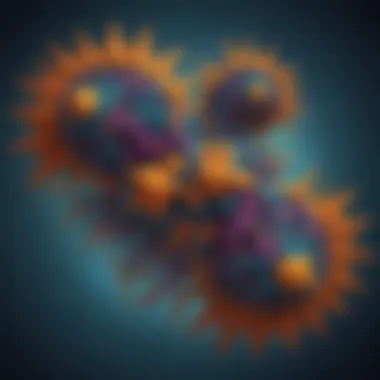
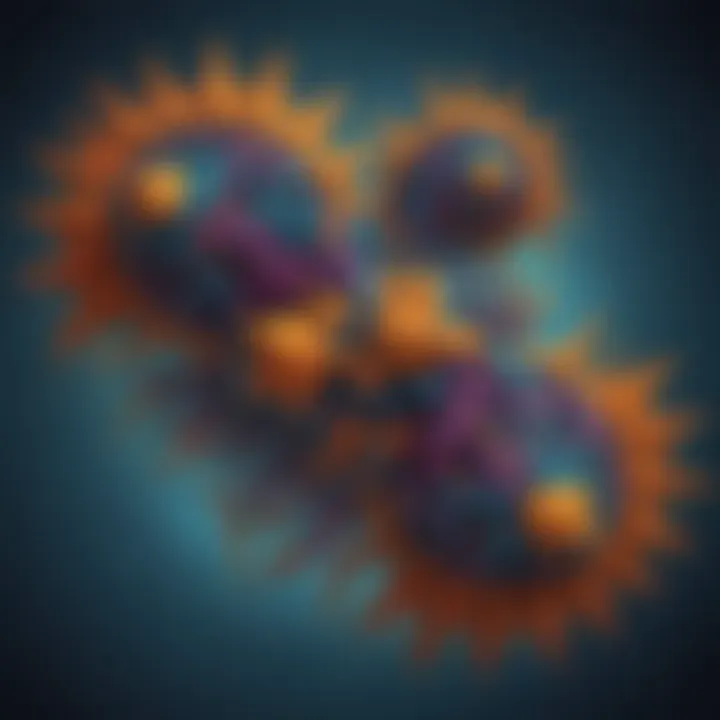
"Fractals are everywhere in nature; they teach us about the order and chaos that define our world."
Exploring fractals is more than just an academic exercise. It broadens our appreciation of symmetry and shape, connecting various scientific disciplines and artistic expressions.
Types of Fractals
Fractals can be categorized into distinct types, each showcasing unique characteristics and applications. Understanding these different types of fractals is crucial for anyone interested in the intersection of art, mathematics, and nature. They not only reveal how fractals can be generated, but also demonstrate their role in various fields. Knowing the types encourages exploration and creativity, making fractals more accessible to individuals of all ages, especially children who are just starting to grasp complex concepts.
Geometric Fractals
Geometric fractals are perhaps the most well-known type. They are created using simple geometric shapes that repeat infinitely. A classic example is the Sierpiński Triangle. This triangle begins with a solid triangle, and then smaller inverted triangles are removed at each iteration. This process continues indefinitely, creating an intricate pattern.
These fractals are not just fascinating visually; they possess mathematical significance. They exhibit self-similarity, meaning that they look similar at any level of magnification. This property can lead to interesting questions about dimensions. Geometric fractals often fit into the concepts of fractal dimension, which expresses how the complexity of a shape changes with scale.
Natural Fractals
In contrast to geometric fractals, natural fractals emerge in the real world. They can be found in various biological and geological structures. Examples include Romanesco broccoli, coastlines, and clouds. These fractals exhibit self-similarity, akin to geometric fractals, but they are less uniform and more organic in appearance.
Natural fractals show how mathematics is present in nature. They assist scientists in understanding various phenomena. For instance, analyzing the branching patterns of trees or the shapes of mountains can reveal insights into ecological systems. Recognizing these patterns can spark curiosity among young learners, encouraging them to observe the world around them.
Random Fractals
Random fractals diverge from the predictability of geometric and natural types. They are generated through random processes, often displaying irregular structures. A prime example of random fractals is the Perlin Noise, commonly used in computer graphics to simulate textures in environments, such as landscapes and clouds.
These fractals might not have clear geometric roots, yet they provide applications in various domains, including computer simulations and art. They reflect the unpredictability inherent in many of nature's processes. The concept of randomness in fractals captivates younger audiences, as it challenges traditional views of order and symmetry.
"Fractals reveal the underlying unity of art and science, merging creativity with mathematical precision."
Understanding the different types of fractals is beneficial for enhancing creativity and analytical skills. It serves as an introduction to the captivating world of mathematics in nature and art.
Creating Fractals
Creating fractals is a crucial component of understanding their intricacies and applications. This section emphasizes the process and the tools that facilitate the creation of these complex structures. By engaging in fractal creation, individuals can grasp deeper mathematical concepts while also expressing their artistic potential. The following subsections offer a comprehensive overview of the tools needed, the steps involved, and various methods one can experiment with.
Tools Needed for Fractal Creation
Fractal creation can involve different tools. Each tool has its advantages, which can enhance the experience of producing fractals. The main categories include software, drawing tools, and programming languages.
Software
Software plays an essential role in the creation of fractals. Programs such as Apophysis and Mandelbulb 3D are specifically designed for fractal generation. They offer unique features that allow for the exploration of various fractal types.
A key characteristic of fractal software is its user-friendly interface, which simplifies complex mathematical formulas. This makes it accessible to beginners while allowing more experienced users to explore advanced features. The visualization capabilities are another advantage, enabling users to see the results of their inputs in real time.
However, a potential disadvantage may arise from the learning curve associated with some software, particularly for those without a background in mathematics.
Paper and Drawing Tools
Paper and drawing tools present a more traditional approach to creating fractals. Using graph paper can aid significantly in visualizing the geometric patterns that define fractals. Pencils, rulers, and compasses are essential for precision.
The tactile experience of hand-drawing shapes offers a unique value that digital tools may lack. This method can be beneficial for understanding the principles behind fractals more intuitively. However, one must realize that hand-drawing can be time-consuming, especially for intricate patterns.
Programming Languages
Programming languages, such as Python or JavaScript, facilitate the creation of fractals through code. This method allows for the automation of complex calculations and the generation of fractals at scale.
One key characteristic of this approach is the flexibility it grants users. Dedicated code can be modified to explore different variances in fractal designs quickly. Additionally, programming provides an opportunity for users to deepen their understanding of algorithms and mathematical concepts.
On the downside, programming may seem daunting for beginners. It requires a certain level of familiarity with logic and syntax, which can be a barrier to entry.
Step-by-Step Guide to Making Your Own Fractals
Creating a fractal can be boiled down to several manageable steps. To start, select the type of fractal you want to create. It may be one defined by a simple iterative process or a more intricate one involving algorithms. From there, you'll need to decide which tools you’ll use, including software or manual methods.
Next, follow the necessary steps based on your chosen approach. If using software, familiarize yourself with its features, such as zooming capabilities or manipulation tools. If drawing, ensure you have quality materials that facilitate accurate measurements. With practice, anyone can produce unique fractal designs.
Experimenting with Different Techniques
Experimentation is key to creating captivating fractals. By trying out various techniques, you can discover new forms and styles.

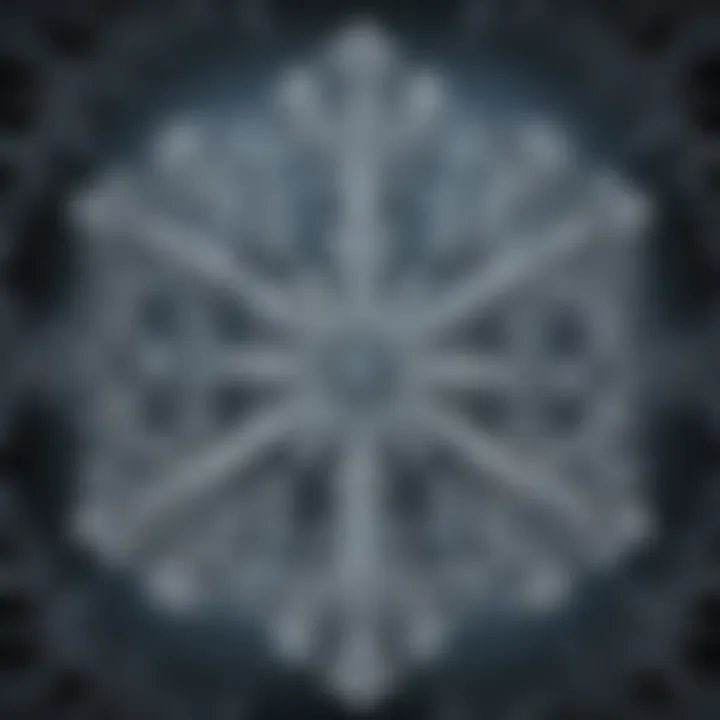
Iterative Methods
Iterative methods involve repeating a simple process to create complex images. This technique is fundamental to fractal generation because it exemplifies how complexity arises from simplicity. A popular choice for beginners, it provides immediate results.
The unique feature of iterative methods is their ability to transform basic shapes over numerous iterations. One disadvantage could be the potential for repetitiveness in the design unless creative tweaks are applied.
Recursion
Recursion is another powerful technique in fractal creation. It refers to a process in which a function calls itself to produce a pattern. This method can create intricate designs efficiently.
A key characteristic of recursion is that it simplifies complex tasks into smaller, manageable parts. This makes it an excellent choice for users with a background in programming. However, it can be challenging to grasp for beginners unfamiliar with the concept of recursion.
Non-linear Dynamics
Non-linear dynamics examines systems that cannot be defined by a straight line. In the context of fractals, this method can produce visually striking results. Non-linear models often lead to unpredictable and complex forms, showcasing the inherent chaos in nature.
Its key feature is that it can mimic real-world phenomena, making it beneficial for artists and scientists alike. Nevertheless, the complexity of non-linear dynamics may require a solid foundation in mathematics to fully utilize its potential.
Fractals in Nature
Fractals are not merely abstract mathematical concepts; they are deeply embedded in the fabric of the natural world. Understanding how fractals manifest in nature reveals their vital role in biological processes, weather systems, and geographical formations. By studying these patterns, we can appreciate the interconnectedness of life and physics. This section will explore specific examples of fractals, emphasizing their significance in various contexts.
Patterns in Biological Structures
Fractals abound in biological structures, showcasing the efficiency of nature's designs. For instance, the branching of trees mimics fractal patterns with each branch splitting into smaller twigs. The vascular systems in animals exhibit similar complex networks, optimizing transport of blood and nutrients.
- Examples include:
- Leaves: The veins often show a fractal pattern for maximum area with minimum material.
- Lung Structures: The bronchial tubes and alveoli maximize gas exchange using a fractal geometry.
These patterns allow for resilience and adaptability, enabling organisms to thrive. They also inspire innovations in fields like architecture and medicine, as researchers look to replicate nature's efficiency in human design.
Fractals in Weather Patterns
The weather is another area where fractals emerge prominently. Think of clouds, tornadoes, and lightning. Each of these phenomena exhibits self-similar structures that repeat on various scales. For instance, if one looks closely at clouds, they notice forms that resemble the broader structure of the cloud itself.
- Key observations include:
- Storm Formation: The intricate pattern of a hurricane’s spiral arms mirror fractal principles.
- Raindrop Patterns: The way raindrops spread upon surfaces follows fractal-like distributions in their shapes and impacts.
Understanding these fractal patterns contributes to better forecasting models. Meteorologists can analyze these repeating structures to predict weather with greater accuracy, proving the practicality of fractal analysis.
Fractals in Geography
Geographic formations are rich with fractal elements, from coastlines to mountains. Coastal outlines are jagged and replete with details at various magnifications, illustrating what is known as the coastline paradox. As one zooms in, the length of the coastline appears to increase infinitely due to its complex structure.
- Some notable examples are:
- Mountain Ranges: The rough contours of mountains display fractal characteristics, with similar patterns appearing at different elevations.
- River Systems: The branch-like patterning of river networks follows fractal principles, crucial for understanding watershed management.
These geographical fractals are immensely valuable. They serve as vital clues in ecological studies and help to inform land-use planning. By utilizing fractal analysis, scientists can better grasp the natural processes and changes on our planet.
Fractals are more than artistic shapes; they are fundamental to understanding how structures in nature operate and evolve.
In summary, fractals in nature demonstrate the elegance and efficiency of natural design. From the delicate patterns of leaves to robust weather systems and vast landscapes, they reflect both beauty and functionality. Recognizing these patterns boosts scientific understanding, inspiring students to appreciate the profound connections between mathematics and the natural world.
Fractals in Art
Fractals hold a significant position in the art world, merging complex mathematics with aesthetic beauty. They provide artists an innovative medium to explore creative expressions. Through their intricate patterns and shapes, fractals stimulate both visual interest and intellectual engagement. As people of all ages marvel at the beauty of fractals, they also encourage discussions about mathematics, science, and art's intersection.
In this section, we will explore the historical perspectives on fractal art, examine contemporary fractal artists, and consider the differences between digital and traditional fractal art. This examination is essential as it highlights how fractals have evolved in artistic practice and how they continue to inspire both creators and onlookers.
Historical Perspectives on Fractal Art
The roots of fractal art trace back to the discoveries of mathematicians like Benoit Mandelbrot in the late 20th century. Mandelbrot defined fractals as shapes that exhibit self-similarity across different scales. These discoveries coincided with the rise of digital technology, which allowed for deeper exploration of these complex patterns.
Fractal art began to gain traction during the 1980s and 1990s. Artists started to embrace computer graphics as a canvas for their explorations. The first fractal images were often created using equations that defined their structures. As technology advanced, more sophisticated software programs became readily available, allowing artists to manipulate fractals in innovative ways.
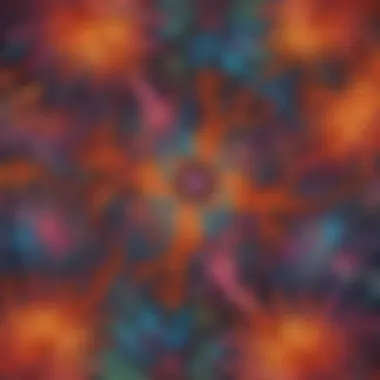
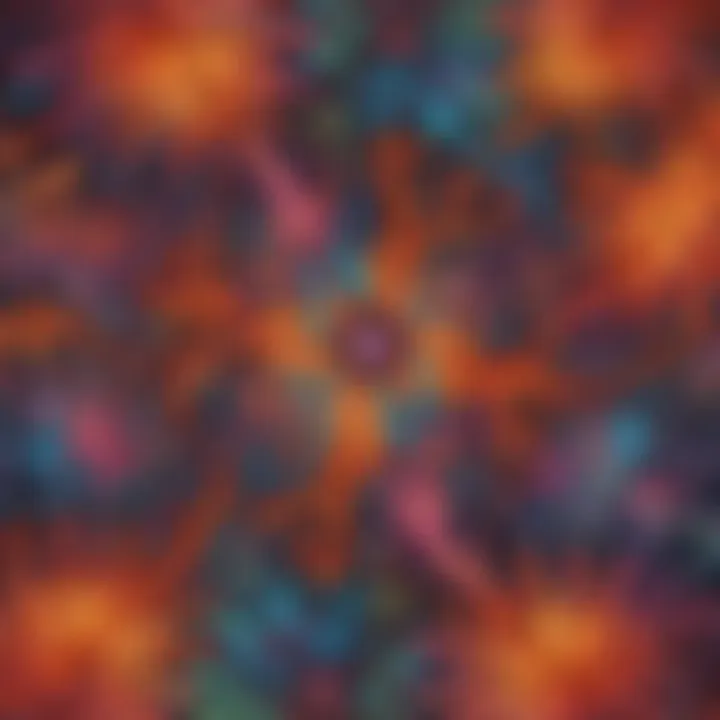
"Fractal art reshapes our perception of both nature and aesthetics, removing the boundaries between mathematics and creativity."
These early works quickly captured the attention of art communities, leading to exhibitions focused solely on fractals. Art movements began to embrace fractals, merging science with artistic expression.
Contemporary Fractal Artists
Today, many artists continue to utilize fractals as part of their work. Figures such as Scott Draves, known for his work on electric sheep, use algorithms to create mesmerizing images that blend art with technology. These artists often explore themes from nature, geometry, and abstract concepts through fractal patterns. They push boundaries by utilizing advanced programming techniques and tools to develop unique and engaging artworks.
Here's a list of notable contemporary fractal artists:
- Scott Draves – Known for the Electric Sheep project.
- Tom Beddard – Creates intricate fractal landscapes and videos.
- Robert Fathauer – Blends mathematical themes with sculpture and art objects.
The interest in fractal art continues to expand, attracting many younger artists eager to explore these mathematical landscapes through both traditional mediums and digital platforms.
Digital vs. Traditional Fractal Art
When it comes to creating fractal art, there are two primary approaches: digital and traditional. Digital fractal art relies heavily on software tools like Apophysis, Mandelbulb 3D, and Ultra Fractal. These programs allow artists to generate complex fractal patterns by adjusting mathematical parameters that define specific shapes.
In contrast, traditional fractal art often involves drawing or painting based on fractal principles. Artists may use geometric shapes and patterns inspired by fractals, yet they approach these designs with manual tools, such as pens and brushes.
Each approach has its benefits:
- Digital Art:
- Traditional Art:
- Allows easy manipulation and adjustment of fractal designs.
- Possibility of creating animations and interactive pieces.
- Enables production of high-resolution images for printing.
- Fosters a hands-on connection with the medium.
- Encourages experimentation with different materials.
- Promotes unique textures and styles in the artwork.
Both forms reflect the endless possibilities and explorations offered by fractals, bridging the gap between mathematics and visual art. Exploring fractals in art provides a dual opportunity: not only does it offer a deeper understanding of complex mathematical concepts, but it also develops a greater appreciation for creativity.
The Importance of Fractals in Education
Fractals serve as a unique intersection between art and science, holding substantial educational value. They enable students to discover mathematical concepts through visual representation and hands-on activities. By engaging with fractals, young minds can grasp abstract theories in a more tangible manner. Through the study of fractals, learners can improve their analytical skills and enhance their creativity simultaneously.
Fractals can introduce students to several key ideas:
- Mathematical Patterns: Understanding symmetry, ratios, and scaling.
- Geometry Concepts: Exploring shapes and how they form complex structures.
- Artistic Expression: Blending math with visual creativity allows personal expression, reinforcing the idea that math is not just numbers but also beauty.
Incorporating fractals into education can also bridge gaps between disciplines. Students can see the connections between math, art, biology, and even computer science.
Fractals as a Teaching Tool
Fractals can be powerful teaching tools. They provide a way to illustrate complex concepts in a cogent manner. When used in classrooms, fractals can spark discussions about various subjects such as mathematics, computer science, and natural sciences.
- Visualization: Fractals offer easy visualization of concepts like infinity and recursion. These can often be difficult to conceptualize through traditional methods.
- Interactive Learning: Using fractals encourages students to engage in problem-solving and exploration. They can create their own fractals using software or manual drawing techniques, fostering hands-on learning.
- Cross-Disciplinary Knowledge: Teachers can use fractals to demonstrate how mathematics applies to the world around us, as they exist in nature and art. This shows students the relevance of their studies beyond the classroom.
Inspiring Young Minds through Fractals
Fractals can ignite curiosity in young learners. When children see the beauty of fractal patterns, they often become more motivated to explore the underlying mathematical principles. The interesting nature of fractals does not only make them captivating; they also challenge students to think critically and creatively.
- Engagement through Exploration: Discovering fractals can be made into projects that involve researching natural fractals, such as coastlines or plants. This encourages young minds to connect math with the environment.
- Competitions and Clubs: Engaging with fractals in settings like math clubs allows students to collaborate, share ideas, and create impressive artwork or projects that incorporate their understanding of fractals.
- Hands-On Activities: Simple activities like creating the Sierpiński triangle or the Mandelbrot set can be very motivating. Children can see immediate results from their efforts, deepening their appreciation for both math and art.
In summary, fractals foster an engaging and comprehensive learning environment. They can illuminate the beauty behind mathematical concepts while simultaneously inspiring creativity. Students exposed to fractals are likely to develop a richer understanding of mathematics and its applications in the world.
Future of Fractals
The future of fractals holds immense promise. It is a fascinating field that intersects art, science, and technology. Understanding fractals can open new doors for exploration in mathematics and beyond. As researchers continue to delve into the properties of fractals, they uncover deeper connections within different scientific fields. This exploration fosters innovation, as fractals are increasingly being applied in surprising and effective ways.
Ongoing Research in Fractal Geometry
Research in fractal geometry is vibrant and continually evolving. Scholars are investigating the applications of fractal patterns across various domains including medicine, data analysis, and physics. For example, fractal analysis can help identify patterns in complex medical imaging, improving diagnosis.
Another area of study is how fractal mathematics can be applied in predicting natural phenomena. By understanding the fractal nature of weather patterns, researchers can enhance forecasting models, making them more precise and reliable. The study of fractals opens up new possibilities for understanding problems that can seem chaotic or random.
"Fractal geometry allows us to see the intricacy of nature and its inherent order within apparent disorder."
In education, ongoing research aims to promote the use of fractals as a teaching tool. Teachers can use fractal concepts to explain complex ideas in a more relatable manner, helping children and students grasp challenging subjects like chaos theory and statistical mechanics.
Technological Advances and Fractals
Advancements in technology are significantly shaping the future of fractals. Software tools have become more sophisticated, allowing for easier creation and manipulation of fractal patterns. Programs like Mandelbulb 3D and Apophysis enable users to visualize and explore fractal dimensions effectively.
Additionally, improvements in computational power mean that researchers can simulate complex fractal behaviors and analyze large sets of fractal data. This leads to groundbreaking discoveries in fields such as computer graphics, where fractals are essential for rendering natural-looking scenes. The capacity to create high-quality visual displays based on fractal principles is also enhancing the video game and film industries, where realistic environments can be constructed efficiently.
Integrating fractal algorithms into artificial intelligence systems can yield interesting outcomes. These algorithms can help AI understand patterns in vast datasets, driving advancements in machine learning and deep learning.







